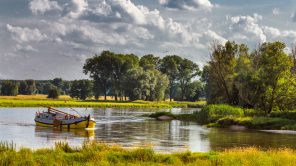On Earth Day we will discuss water – as we all need it to live. We care for it on a daily basis by implementing water management during this difficult time of climate change. Water deficits combined with a growing population has now become a significant global challenge. For Poland too.
We are among the group of countries with the lowest water resources in the entire European Union. 1,600 m3 of water is available per Polish citizen per year. And this calculation does not include the personal needs we each have. It is an averaged division of water resources in our country per citizen (including all needs, as well as the demands of industry and the power sector). What does it mean in practice? It means that we are really short of water in Poland. What is more, during drought periods this average decreases to 1,000 m3 of water per citizen. Therefore, for two years, our team at the National Water Management Authority has been working on the ‘Stop drought!’ programme. Within its framework, we have developed the first drought effects counteraction plan in Poland. Thanks to the comprehensive recommendations, the document will contribute to improved national water security. More information about the project can be found at: www.stopsuszy.pl
At the National Water Management Authority we have been implementing responsible and sustainable water management, as befitting the 21st century. We have three main targets: ensuring flood safety, alleviating drought effects and caring for the water quality. We have been undertaking actions answering the needs of the economy and the natural environment. Today, in this period of drought, protection and securing water resources have become the key challenges. More so, since the rivers and water bodies in our country are primarily supplied by rainwater. After a snowless winter and the high temperatures for this season, we have experienced drought as early as the spring. Our surface water resources have not been restored because of the water deficit in the environment, present for the last few years. It is a big challenge for us all, especially for agriculture. At the National Water Management Authority, we have developed a modern project for improving water balance on arable areas. Together with local governments and water companies involving farmers, we have created a pilot programme for managing water resources in agricultural areas. It consists of the management of channel retention, restoration of coastal river backwaters, and the construction or reconstruction of valves on drainage and irrigation ditches. It is a highly comprehensive approach, as it combines the needs of agriculture and the environment. We aim to implement the solution throughout the country. More information on the topic can be found in the following publication: https://www.wody.gov.pl/mala-retencja/retencja-korytowa/retencja-korytowa-przywroci-funkcje-nawadniajace-systemow-melioracyjnych
What is more, we have been introducing and promoting other solutions in the scope of small water retention projects as part of our actions, supporting water balance at a local scale. For instance, we recommend restoring waterholes, ponds, and other smaller water bodies. In addition, we encourage innovative and efficient solutions for cities, such as disposal wells, rain gardens and other systems impeding rainwater run-off and further contributing to retention. In rural areas, we encourage the use of old and proven solutions, such as buffer strips, which increase soil humidity in fields by as much as a quarter.
Apart from the actions related to small water retention projects, it is necessary to construct large reservoirs to ensure water security for whole regions. It is the only efficient way of ensuring appropriate amounts of water in the present state of climate change. Retention reservoirs collect water in periods of intense rainfall and constitute a backup for droughts. This enables the survival of aquatic ecosystems, which also largely impede the drought processes. This is because reservoirs increase valley storage and balance out the level of ground waters. Multi-functional retention reservoirs further reduce the flood risk, which is important as heavy rains form an increasingly common phenomenon after drought periods, when the amount of rain corresponding to the monthly average for a given region may fall in one day.
At the Authority, we take a comprehensive look at water management. We view the current needs as well as the perspective of the next one hundred years. Apart from the shortage of water, its quality has become a modern challenge. This in particular applies to pharmaceutical pollution. Experts have been indicating the scale of this problem. We discuss the topic in greater detail in this article: https://www.wody.gov.pl/aktualnosci/491-farmaceutyki-w-srodowisku
We have been constantly encouraging everyone to respect and save water. The residents of cities and villages – at the individual as well as business level – including entrepreneurs and local government officials. For instance, we recommend replacing lawns (requiring thousands of litres of water) with flower meadows – they are fragrant, restore humidity to the environment and support bio-retention. Flower meadows are perfect for home gardens as well as parks and city squares. More information is available in our publication: https://www.wody.gov.pl/mala-retencja/kwietne-laki-na-okres-suszy
A question often raised during the periods of drought is: will we run out potable water in Poland? The answer is no, because over 70% of water intended for the population originates from underground sources, ensuring the safety and availability of drinking water. However, during the periods of increased demand, typically in the summer, restrictions on the use of tap water may occur. That is why it is so important to use water frugally and thoughtfully. Details on this topic are available in our article: https://www.wody.gov.pl/aktualnosci/1017-wody-pitnej-nam-nie-braknie
Water management is a process where the key aspect is the adaptation to climate change and its associated phenomena. Specifically extreme hydrological phenomena, such as floods and droughts. We experience alternate dry and humid periods in our climate zone. As recently as the mid-20th century, droughts occurred in Poland every 5 years on average. At present, we face them every year in the spring-summer season. This does not rule out the appearance of heavy rains or a period of humid years. We should be ready for them. Thus the actions of the National Water Management Authority focus on a comprehensive approach to water management. An approach that is responsible and prospective. What is more, we care about raising social awareness, that water is the most precious good, to be cared for at the individual, local and national levels. Therefore, we actively participate in water education through our activities. We encourage you to follow our Facebook profile and our website.
Social Communication Team
National Water Management Authority



Your point of view caught my eye and was very interesting. Thanks. I have a question for you.